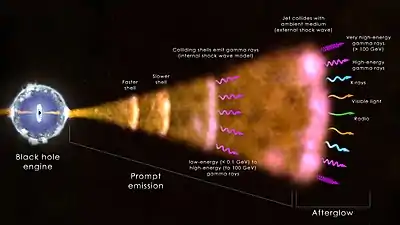GRB 190114C
GRB 190114C was an extreme gamma-ray burst explosion from a galaxy 4.5 billion light years away (z=0.4245;[2] magnitude=15.60est[3]) near the Fornax constellation,[4][5][6] that was initially detected in January 2019.[3][7] The afterglow light emitted soon after the burst was found to be tera-electron volt radiation from inverse Compton emission, identified for the first time.[8] According to the astronomers, "We observed a huge range of frequencies in the electromagnetic radiation afterglow of GRB 190114C. It is the most extensive to date for a gamma-ray burst."[8] Also, according to other astronomers, "light detected from the object had the highest energy ever observed for a GRB: 1 Tera electron volt (TeV) -- about one trillion times as much energy per photon as visible light";[4] another source stated, "the brightest light ever seen from Earth [to date] ... [the] biggest explosion in the Universe since the Big Bang".[9]
 The Hubble Space Telescope caught the fading afterglow of GRB 190114C and its home galaxy on February 11 and March 12, 2019. The difference between these images reveals a faint, short-lived glow (center of the green circle) located about 800 light-years from the galaxy’s core. Blue colors beyond the core signal the presence of hot, young stars, indicating that this is a spiral galaxy somewhat similar to our own. The source of the burst is located about 4.5 billion light-years away in the direction of the constellation Fornax. | |
| Event type | Gamma-ray burst |
|---|---|
| Right ascension | 03h 38m 1.63s[1] |
| Declination | −26° 56′ 48.1″[1] |
| Redshift | 0.4245 ±0.0005 |
| Other designations | GRB 190114C |
| | |
Significance
Recent publications following the event indicate that inverse Compton scattering is the mechanism responsible for producing TeV photons.[8] X-ray photons are scattered off of the GRB's polar jets of electrons, which move at 0.9999c. In a scattering event, much of the energy of a relativistic electron is transferred to a photon.[10][11][12][13] Researchers "have been trying to observe such very high energy emission from GRB's for a long time, so this detection is considered a milestone in high-energy astrophysics".[4][14] The most recent studies propose, in summary, a model of binary system of hypernova (BdHN I) with two neutron stars, where one of them collapses in a black hole, surrounded by an accretion disk and from whose poles the GRB is launched.[15][16]

.jpg.webp)
References
- Staff (2019). "SIMBAD - GRB 190114C". SIMBAD. Retrieved 20 November 2019.
- Staff (2019). "GRB 190114C". University of Chicago. Retrieved 24 November 2019.
- Palmer, David (14 January 2019). "GRB 190114C: Swift detection of a very bright burst with a bright optical counterpart". Goddard Space Flight Center. Retrieved 20 November 2019.
- ESA/Hubble Information Centre (20 November 2019). "Hubble studies gamma-ray burst with the highest energy ever seen". EurekAlert!. Retrieved 20 November 2019.
- Byrd, Deborah (24 November 2019). "Epic cosmic explosion detected via faster-than-light particles - Space-based observatories detected a violent explosion in a galaxy billions of light-years away. It became the brightest source of high-energy cosmic gamma rays seen so far. Specialized Earth-based telescopes detected it via faster-than-light particles cascading through Earth's atmosphere". Earth & Sky. Retrieved 24 November 2019.
- Zhang, Ben (20 November 2019). "Extreme emission seen from γ-ray bursts - Cosmic explosions called γ-ray bursts are the most energetic bursting events in the Universe. Observations of extremely high-energy emission from two γ-ray bursts provide a new way to study these gigantic explosions". Nature. 575 (7783): 448–449. arXiv:1911.09862. doi:10.1038/d41586-019-03503-6. PMID 31748718.
- Mirzoyan, Razmik (15 January 2019). "First time detection of a GRB at sub-TeV energies; MAGIC detects the GRB 190114C". The Astronomer's Telegram. Retrieved 20 November 2019.
- University of Johannesburg (22 November 2019). "Caught in afterglow: 1st detection of Inverse Compton emission from dying gamma-ray burst". EurekAlert!. Retrieved 23 November 2019.
- Wood, Tom (22 November 2019). "Scientists Detect Biggest Explosion In The Universe Since The Big Bang". LADbible. Retrieved 23 November 2019.
- Evgeny Derishev; et al. (2019). "The Physical Conditions of the Afterglow Implied by MAGIC's Sub-TeV Observations of GRB 190114C". The Astrophysical Journal. 2019 (2): L27. arXiv:1905.08285. Bibcode:2019ApJ...880L..27D. doi:10.3847/2041-8213/ab2d8a. S2CID 160010082.
- The H.E.S.S. collaboration (2019). "A very-high-energy component deep in the γ-ray burst afterglow". Nature. 2019 (7783): 464–467. arXiv:1911.08961. Bibcode:2019Natur.575..464A. doi:10.1038/s41586-019-1743-9. PMID 31748724. S2CID 208175979.
- The MAGIC collaboration (2019). "Teraelectronvolt emission from the γ-ray burst GRB 190114C". Nature. 2019 (7783): 455–458. arXiv:2006.07249. Bibcode:2019Natur.575..455M. doi:10.1038/s41586-019-1750-x. hdl:2318/1718773. PMID 31748726. S2CID 208190569.
- The MAGIC Collaboration (2019). "Observation of inverse Compton emission from a long γ-ray burst". Nature. 2019 (7783): 459–463. arXiv:2006.07251. Bibcode:2019Natur.575..459M. doi:10.1038/s41586-019-1754-6. PMID 31748725. S2CID 208191199.
- Veres, P; et al. (20 November 2019). "Observation of inverse Compton emission from a long γ-ray burst". Nature. 575 (7783): 459–463. arXiv:2006.07251. Bibcode:2019Natur.575..459M. doi:10.1038/s41586-019-1754-6. PMID 31748725. S2CID 208191199. Retrieved 20 November 2019.
- Ruffini, R.; Fuksman, J. D. Melon; Vereshchagin, G. V. (2019). "On the Role of a Cavity in the Hypernova Ejecta of GRB 190114C". The Astrophysical Journal. 883 (2): 191. arXiv:1904.03163. Bibcode:2019ApJ...883..191R. doi:10.3847/1538-4357/ab3c51.
- Rueda, J. A.; Ruffini, Remo; Karlica, Mile; Moradi, Rahim; Wang, Yu (2020). "Magnetic Fields and Afterglows of BdHNe: Inferences from GRB 130427A, GRB 160509A, GRB 160625B, GRB 180728A, and GRB 190114C". The Astrophysical Journal. 893 (2): 148. arXiv:1905.11339. Bibcode:2020ApJ...893..148R. doi:10.3847/1538-4357/ab80b9. S2CID 212725357.
- "Hubble Studies Gamma-Ray Burst with the Highest Energy Ever Seen". Hubble Space Telescope. Retrieved 21 November 2019.
Further reading
- Vedrenne, G.; Atteia, J.-L. (2009). Gamma-Ray Bursts: The brightest explosions in the Universe. Springer. ISBN 978-3-540-39085-5.
- Chryssa Kouveliotou; Stanford E. Woosley; Ralph A. M. J., eds. (2012). Gamma-ray bursts. Cambridge: Cambridge University Press. ISBN 978-0-521-66209-3.



